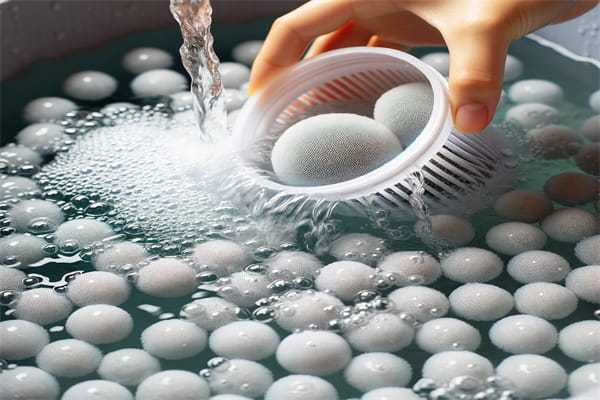Filter balls are an increasingly popular choice for filtration in swimming pools, aquariums, and various industrial applications due to their efficiency and eco-friendliness. Properly conditioning these filter balls before their first use is essential to ensure they perform optimally and last longer. In this article, we’ll walk you through the necessary steps to condition your filter balls, helping you achieve the best filtration results right from the start.

Ⅰ.Introduction to Filter Balls
Filter balls are lightweight, reusable, and highly efficient filtration media made from a variety of materials, including polyethylene and polyester fibers. They are designed to trap debris and impurities while allowing water to flow freely through the filtration system. Unlike traditional sand or cartridge filters, filter balls require less maintenance, are easier to handle, and provide superior filtration performance. They are used in swimming pools, aquariums, and even industrial applications due to their versatility and effectiveness.
Ⅱ.Importance of Conditioning
Conditioning filter balls before their first use is a crucial step to ensure they perform optimally right from the start. Proper conditioning helps remove any dust, loose particles, or manufacturing residues that may be present on the filter balls. This process also helps the filter balls settle into the filtration system, ensuring even distribution and preventing potential clogging. By conditioning your filter balls, you can extend their lifespan and maintain a high level of filtration efficiency.
Ⅲ.Step-by-Step Guide to Conditioning Filter Balls
1. Inspection
- Inspecting your filter balls before their first use is essential to identify any visible damage or defects. This step helps avoid potential issues that could compromise the performance of your filtration system.
- During the inspection, look for any tears, inconsistent shapes, or debris. Filter balls should be uniform in size and shape, and free from any noticeable damage.
2. Rinsing
- Rinsing the filter balls helps remove any dust, loose particles, or manufacturing residues that may have accumulated during packaging and transport. This step ensures that your filter balls are clean and ready for optimal filtration.
- To rinse your filter balls, place them in a large container or bucket. Use clean, cold water and gently agitate the filter balls to ensure thorough cleaning. You can also use a garden hose to rinse them, making sure to cover all surfaces evenly. Continue rinsing until the water runs clear.
3. Soaking (Optional)
- Some manufacturers recommend soaking the filter balls to ensure they are fully saturated, which can enhance their initial performance. Soaking helps the filter balls achieve the right level of moisture and ensures they are ready to function effectively from the start.
- To soak the filter balls, fill a large container or bucket with clean, non-chlorinated water. Submerge the filter balls in the water and let them soak for a few hours or overnight. After soaking, drain the water and give the filter balls a final rinse.
4. Installation

- Installing the filter balls correctly is crucial for maximizing filtration efficiency. Ensure that the filter balls are evenly distributed within the filter housing. This even distribution helps prevent clogging and maintains a consistent water flow through the system.
- Always refer to and follow the specific instructions provided by the filter ball manufacturer. Each brand may have unique guidelines for installation, so it’s important to adhere to their recommendations for the best results.
5. Initial Run
- Running the filtration system for a short period after installing the filter balls helps them settle into place and start working effectively. This step ensures that the filter balls are properly positioned and ready for optimal filtration.
- Run the filtration system for 15-30 minutes and monitor for any irregularities, such as unusual noises, leaks, or changes in water flow. This initial run helps identify and address any issues before they become significant problems.
6. System Check
- After the initial run, check the filtration system for any leaks. Inspect all connections and seals to ensure they are secure and functioning correctly. Address any leaks promptly to maintain the integrity of the system.
- Maintaining a consistent water flow is essential for effective filtration. Monitor the water flow to ensure it remains steady and that the filter balls are not causing any blockages. Regularly check the system to confirm that the filter balls are performing as expected.
Ⅳ.Conclusion
Properly conditioning filter balls for first-time use is a straightforward process that can significantly enhance their performance and longevity. By following these steps—inspection, rinsing, soaking (if recommended), installation, initial run, and system check—you can ensure that your filter balls are ready to provide superior filtration from day one.

 Instant
Quote
Instant
Quote Email
Us
Email
Us